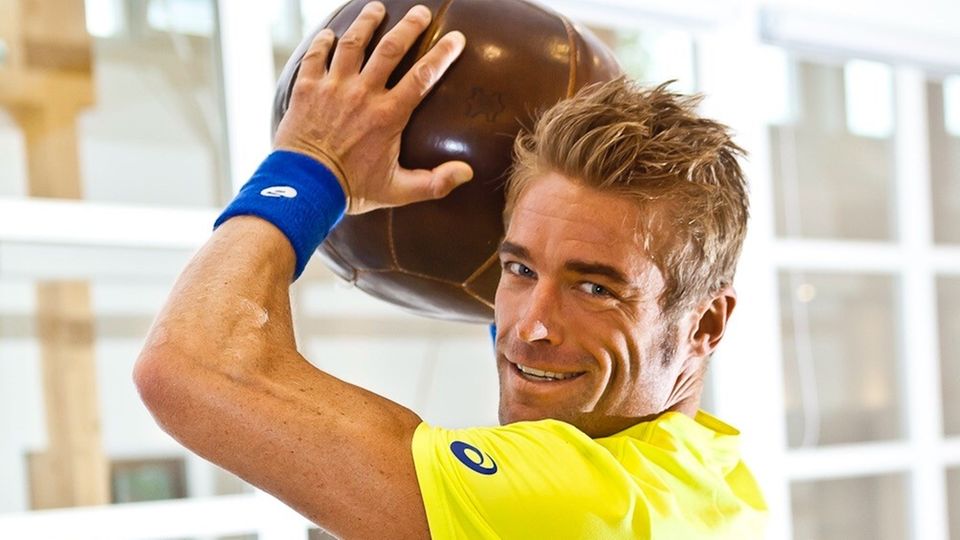Workout in the living room
Stay fit despite the mobile office: the expert recommends these devices
The emergency solution Home Office has long since become everyday life. Ex-triathlon professional Maximilian Longrée knows which muscles are neglected in the mobile office and gives tips for the mini-gym.
The coronavirus has largely disappeared from everyday life. But it left traces. This becomes particularly clear in the world of work. Because the interim model Home Office has developed into a flexible model called Mobile Office. This has some advantages but also disadvantages. Because millions of people in Germany are now crouching at the home desk on two to three days a week, although they could urgently use compensation and movement. Or better: the often neglected muscles are challenging.
In most desktakers, chest, leg and back muscles deadline a rather miserable existence. The fitness level greets out of the basement, muscle structures have shortened and gradually break down. In addition, the body uses little energy when sitting. And because many rightly approve one or the other treat after work, the hour of new grease handle beats.
Personal Coach, Ironman winner, author and fitness expert explains which muscles in the mobile office suffer very much, why simple gadgets can remedy the situation and not everyone needs their own weight bench. Maximilian Longrée In the interview. The 42-year-old former professional triathlete won the amateurs’ World Cup title at the legendary Ironman Hawaii in 2006. In the meantime, he advises and cares for companies and private individuals in the areas of fitness and nutrition. (You can find more information about Maximilian Longrée .)
Maximilian Longrée, how does regular or even permanent work in the mobile office affect our fitness state?
From a physical point of view, we are primarily dealing with muscle breakdown. And regardless of the fitness level, i.e. also in people whose muscle content is not as pronounced, for example with hobby athletes who regularly go to the gym. In people who do little sport in their free time, everyday movements such as the path to the car or climbing stairs in the company are more common. In this group, however, muscle reduction is less noticeable than with active athletes that have built up muscles and cultivated them. With increasing mobile office, the muscles go back more, the basal metabolism decreases and they start fat because they move less and may eat even more than before.
Which muscle groups are mainly affected?
The muscles not only atrophy. It is also increasingly shortening because the stretching effect, which is part of every everyday movement, is often eliminated in the mobile office. Conventional office diseases or complaints are increasing. The classics such as neck pain or the infamous piriformis syndrome, i.e. the pinched sciatic nerve, could be more violent or occur in people who had no problems with it because they at least moved-and if it was only the way to the canteen or climbing stairs. Above all, the leg muscles, our largest muscle group, steals through the lack of movement.
Now you can put up with it or, you have already said, do something about muscle reduction. Now not everyone has the place for a gym at home. How can you still do something good for the neglected muscles?
It depends heavily on the current fitness level. I would be simple for everyone who has hardly exercised and just want to preserve their muscles and health Recommend in different strengths. That sounds banal, but you can implement many classic exercises. For example, do something for the shoulder blade or chest muscles to sit more upright on the office chair again. This is sufficient for this because it doesn’t take particularly large engines to maintain the muscles or even build something. As an additional exercise, I think pushup on knees makes sense. I recommend everyone who doesn’t feel like it: take a walk and take the stairs instead of the elevator on the way to the apartment. Those who do this should be able to keep their fitness level well.
What about those whose muscles suffer involuntarily because you have not seen your gym from the inside? I my athletes who otherwise trained there two or three times a week.
It gets a little trickier. Although these athletes are more efficient and can therefore also do exercises independently that I would not recommend less active people. I think of squats first – with or without weight. Or also side lifts with In every hand for the shoulder muscles. Basically, the higher the fitness level, the more difficult it is to maintain the status quo or even build muscle mass. Nevertheless, the worst thing you can do is nothing to do for the body anymore. I also find it important that you are free to be able to keep the level from the time before coronaemy, let alone achieve top shape.
Which devices do you think is appropriate for the in -house gym?
In addition to a In my view, a storage rack and a small selection are worthwhile for more ambitious athletes . This does not take up too much space and is also suitable for rental apartments. If you have no space for this, you can still work with your own body weight or with the fitness straps mentioned.
On a large scale, you can find out about the current models.
*This article contains so-called affiliate links to products in online shops. If a user clicks on it and buys something, the publisher receives a commission from the dealer, not from the manufacturer. Of course, where and when you buy a product is up to you.
Source: Stern
I am Pierce Boyd, a driven and ambitious professional working in the news industry. I have been writing for 24 Hours Worlds for over five years, specializing in sports section coverage. During my tenure at the publication, I have built an impressive portfolio of articles that has earned me a reputation as an experienced journalist and content creator.




